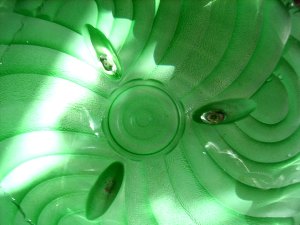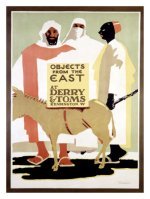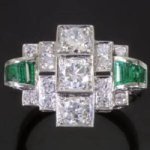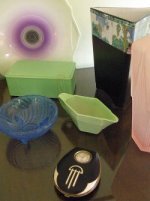More Major Art Deco Glassmakers
Some links from this site lead to third parties who pay us a commission if you buy something. This allows us to keep providing the information on this site free of charge!
A few of the major Art Deco Glassmakers active in the 1920s and 1930s are described on this page. They produced pieces still highly sought after today.
Gabriel Argy-Rousseau (1885-1953). Famous for his works in the "Pâte de verre" technique, he formed a partnership with Moser-Millot from 1919 until 1931. He made a series of Art Deco glass enamelled perfume bottles, and many vases, lamps, and bowls, as well as jewellery.
Baccarat. This long established French glassmakers was a major competitor of Lalique and Emile Gallé during the 1920s and 30s. They made perfume bottles for all the major perfumers, and shared a stand with the Art Deco gold and silversmith Christoflé at the 1925 Paris Exhibition. Their perfume bottle for Guerlain's L'Heure Bleue of the time displayed a label with the famous Art Deco fountain motif, very similar to the "fountain of perfume", Lalique's crowning glory of the perfume pavillion. Their work of the time employed geometric motifs, enamelling and angular shapes.
Carder (1863-1963). British born Frederick Carder worked
for various potteries and glass companies before departing for the
United States in 1903. He was a highly talented and innovative
glassmaker and was still developing new colours and techniques when he
retired aged 96. He founded the Steuben Glass Company in New York where
he produced French style high Art Deco pieces which competed with
Tiffany. He developed bright iridescent colours and produced over 6000
different shapes during his long career.
Daum
Frères. Founded in 1875 in Nancy, this French
Glassmakers produced an enormous amount of fabulous Cameo glass in the
Art Nouveau period. In the 1920s and 30s their Art Deco output was
headed by Paul Daum, and consisted mainly of thick, heavy etched pieces
in grey, turquoise, yellow and sea green with either geometric or floral
designs.
More Art Deco Glassmakers
François-Emile
Décorchement (1880 - 1871). Noted for his work in "Pâte
de verre" and "Pâte de cristal", Décorchement developed a marble-like,
thick-walled glass, using colour streaks obtained by the use of
chemicals. He made almost transparent pieces with stylised floral
motifs. Post World War I he made bold, rigid cuboid forms with
geometrical decoration. He finished his career working mainly in
stained glass for churches.
Edmond
Etling. The Paris factory of Etling et Cie was active in
the 1920s and 1930s. Etling figures of draped female nudes, animals and
ships made of opalescent glass were mass produced in the 1920s and are
the most collectable of his work today.
Maurice
Marinot (1882 - 1960). A painter and a member of Les
Fauves, Maurice Marinot became fascinated with glass and produced over
2500 vases, jars, bottles and sculptural figures until 1937 when he went
back to painting. He made all his pieces by hand, using coloured
enamels, as well as thick walled glass containing bubbles or specks of
colour, and deeply etched pieces.
Marius-Ernest
Sabino (1878 - 1961). Inspired by Lalique and one of his
foremost competitors, Sabino also had his own display at the 1925 Paris
exhibition. He was well-known for lighting and produced all the
lighting for the Salons d'Automne Art Exhibitions, and created pieces
for the ocean liner, the Normandie. He also made hood ornaments for
automobiles, sometimes direct copies of Lalique's mascots. His work did
not have the imagination or flair of Lalique, but his best pieces are figures of stylised women. The Sabino factory closed down in 1939.
Etsy has a surprisingly good range of Art Deco furniture, interior decor, art and prints, 1920s and 1930s fashion, accessories, jewellery and Bakelite. Click the banner to explore.
Join our Facebook Page so you never miss a thing!
Like this Page
- Decolish Home
- Art Deco Glassmakers



